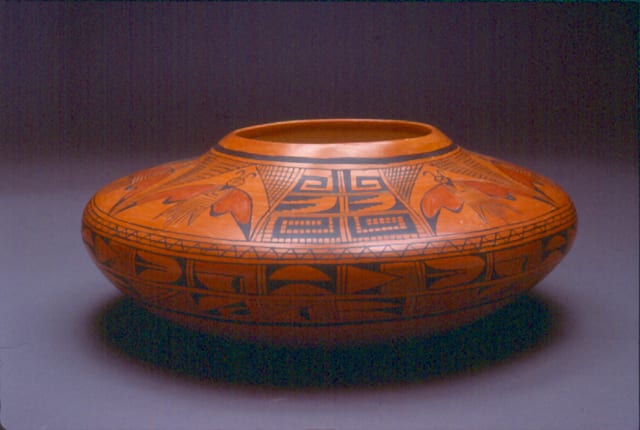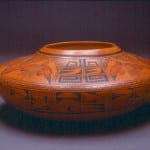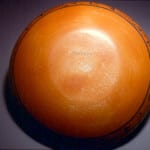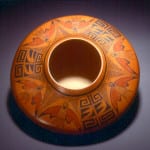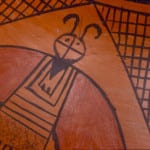Hopi Sikyatki low-shouldered vase with butterfly design, mutton-fat polish, Marcella Kahe, Schomovi, First Mesa. Ms. Kahe is a neighbor of Rosetta Huma (1983-04), mother of Karen Charlie (1995-06, 2024-11), and the mother-in-law and teacher of Gloria Kahe (1991-01 and 1991-02).
See Fewkes (1973:54-56, 152, and 175) for discussion of the original pot that probably served as an inspiration for this modern version. On the original pot, the six butterflies are interpreted by Fewkes as females if head incorporates an “X,” males if crosshatched (on the modern bowl, a “+”). The six butterflies are further interpreted by Fewkes as representing the six cardinal points (north, south, and above = male; east, west, and below = female). Between the butterflies on the original vase was a zone of design incorporating stylized feathers, key patterns, crosshatched crooks, triangles, and frets. “This vase may be considered the most elaborately decorated in the whole collection from Sikyatki,” Fewkes writes (1973:56). For a modern (black and white) photograph of this Sikyatki pot, see Brew (1979:516).
In contrast to the original design, Kahe has grouped the butterflies in three groups of two. The design zone between the three butterfly groups incorporates her original composition of traditional Hopi designs. (Note that the original Sikyatki design zone is more closely interpreted by Alma Chapella Tahbo on 1989-07 and Dianna Tahbo, 1992-06.) Kahe’s design is then pulled together by three areas of cross-hatching over the three groups of butterflies. Marcella’s designs are unusual in that she extends the design surface around the edge of her pots and onto the lower surface (See also, 1992-07).
Marcella (age 73 when she made this pot) was born on August 3, 1916 at First Mesa. Her Mother (Emma Adams) taught her pottery making. She did not attend the 1989 Indian Market since she is the Clan Mother of the Butterfly-Badger Clan and was helping organize a Clan dance that weekend. She lives in the village of Sichomovi, First Mesa. I visited Hopi in the fall of 1989 and Marcella’s daughter Karen introduced me to her. Marcella liked strong coffee and cookies and I brought these with me for her when I visited her over the next 19 years until her death in 2008. She did not remember my name but would belt out “Hello Houston” when I appeared at her door. On October 9, 1993, she was named an “Arizona Indian Living Treasure” at a ceremony in Sedona and I sent flowers. For another pot by Marcella, see 1992-07.
I saw a very similar pot by Marcella at King Galleries (Scottsdale, AZ) in May 2002.

